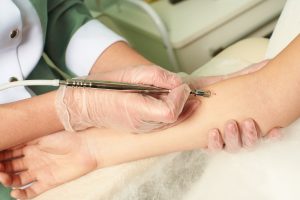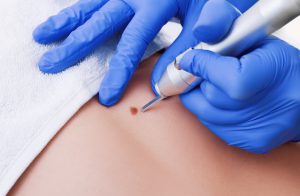Mole Removal with Mole Check Clinic
Mole removal methods can sometimes be necessary when moles aren’t only unwanted, but also posing a risk of the development of skin cancer. Mole removal isn’t required for every mole. However, some people also choose to remove unsightly moles or simply unwanted moles.
What is a Mole?
A nevus mole (nevus is the medical name) is essentially a cluster of cells that produces melanin, and most of them are harmless. They’re usually round or oval in shape and can be either flat or raised, with colouring ranging from skin tone to black. They can appear on any part of the body.
Types of Moles
Atypical
Atypical moles are unusual looking benign moles that have irregular features when looked at under enlarging lenses. They’re not necessarily cancerous moles, yet having atypical moles is a risk factor for developing melanoma skin cancer. It’s thought atypical moles arise due to a mixture of genetic and environmental reasons, but the exact causes are still unknown.
While sometimes an atypical flat mole can be benign, due to the link with skin cancer, you should contact your dermatologist or skin cancer clinic if you notice itching, bleeding or swelling, pain, or changes in colour, size, shape, texture or elevation of a mole. These changes may necessitate mole and skin tag removal. It’s worth keeping an eye on atypical moles, as they can be dangerous due to their correlation with skin cancer.
Benign
A benign mole, skin tag or seborrheic usually takes a well-defined symmetrical shape and is one colour only against your skin. They can be a flat mole or a bump, but most importantly, their appearance will not change over time. These moles are not inherently dangerous, yet all moles should be checked by a qualified skin doctor over time to ensure they’re not changing in appearance. If your moles are benign but you would prefer to have them removed for aesthetic or practical reasons, there are various mole removal procedures and techniques available.
How Can a Mole Be Diagnosed?
There are various ways a mole can be diagnosed:
Dermascope Spot Check
A mole can be checked on a detailed basis using a tool called a dermascope, which enlarges the view of the mole so that a doctor can take a good look at its features.
Full Body Mole Map
A full body mole map involves taking pictures of your body so that locations and features of moles can be accurately recorded. In subsequent years, developments in your moles can be compared to earlier mole maps for quick pinpointing of changes.
Skin Cancer Check
A dermatologist or skin doctor can inspect every inch of your skin, looking at any moles or other lesions for signs of skin cancer. Any suspicious moles will be photographed during the session for more detailed analysis.
Treatment Options
Surgical
Excision
- A biopsy usually proceeds excision
- Uses anaesthesia and may require stitches
- Mole area will be measured, mapped and photographed
- Recovery time may be days to weeks
- Stitches out in 2 weeks
When a doctor believes a mole may be cancerous and needs to be checked by the laboratory or must be removed for any other reason by surgery, then a biopsy is performed. If the mole is confirmed to be cancerous or otherwise posing a health risk, then more surgery is usually required.
Excision biopsy is performed when it is necessary to cut out the entire mole. A small amount of local anaesthetic is applied around the mole, which is then cut out together with some surrounding tissue. A couple of stiches are required to close the wound, so a small scar will inevitably result which will fade with time.
Punch
- May leave a small scar
- Uses anaesthesia
- Often no stitches required
- Heals in a few weeks
Punch biopsy, as with full excision, cuts out the entire mole. It leaves a small scar or none. However, it can only be performed on moles which are quite small. A small amount of local anaesthetic is applied around the mole as with a normal excision. However, punch excision is much less invasive. A special tool is used to remove the desired portion of skin from the target area. As the diameter of the area is quite small, often no stitches are required. After punch excision, the skin looks like it has been pierced by a sharp object.
Shaving
- Uses a small amount of anaesthesia
- No stitches usually required
- Minimal or no scarring
- 5 days average recovery
Certain moles can be shaved down using a special instrument. Only the top layer of the mole is removed. The depth of the incision may vary depending on the circumstances. A small amount of local anaesthetic is normally used to numb the area around the mole. Normally no stitches are required and therefore minimal or no scarring occurs. The procedure is frequently used to remove moles raised above the surface of the skin.
Non-Surgical
Radiofrequency
- Fast healing
- Less bleeding and scarring
- No stitches necessary
- Full recovery in 1 week
High frequency radio wavelength, when channelled through an electrode tip, can be used to cut through skin. We use a medical device called Hyfrecator 2000. Its reputation is well known in Australia. There are many advantages of using radiofrequency to remove raised, not harmful moles by shaving them off. There is much less bleeding, scarring and swelling, the wound heals much faster, and there is less chance of an infection. It can be used on any part of the body. As there is no stitching required, the cosmetic outcomes can be exceptional.
However, only certain moles can be removed by radiofrequency. They are generally raised and not harmful. Therefore, it is very important to have a proper consultation with an experienced doctor to make the right choice.
Anaesthetic is always applied to the area before the doctor starts removing the lesion one layer at a time to achieve a flat surface. Once the desired outcome is achieved, only a light dressing is required. Full recovery is achieved in approximately one week.
Cryotherapy
- Fast procedure
- Near painless
- Highly effective
Cryotherapy uses extreme cold, usually liquid nitrogen, to remove targeted skin lesions and essentially freeze off a mole. The cells inside the lesion are completely destroyed and are removed by the body’s immune system or form a scab and fall off.
Cryotherapy is primarily used to freeze warts, skin tags, harmless moles, blood spots, solar keratosis and sun spots. Procedures are fast, almost painless and very effective. More than one treatment may be required to achieve the desired result depending on the size and the depth of the lesion.
Recovery
You will receive clear instructions on wound management after your procedure depending on which of the mole removal methods has been used. Normally the recovery after excision is very minimal. Even after the full excision, the swelling usually disappears after a few days. It is important to keep the treated area clean to avoid infection. Staying out of direct sunlight is also necessary to facilitate the healing process and to avoid scarring. Stretching the site of surgery is not advisable, as it may cause bleeding and increase the size of the scar.
The most common risks of surgical mole removal are bleeding, bruising, infection and scarring. It is therefore very important to advise your doctor if you are diagnosed with excessive bleeding.
FAQs
How Much Does Mole Removal Cost?
The mole removal cost will depend on which of the available mole removal methods is used and how involved it is.
Can Moles Grow Back After Removal?
It is possible for moles to grow back if some cells from the mole were left after the initial removal, however it is unlikely. If you want to make sure your mole does not grow back, ask your skin doctor about surgical methods of mole removal.
On Which Parts of the Body Do Moles Form?
Moles can appear anywhere on your body, including between fingers or toes, on the face, under the armpits and even under the nails.
Can a GP Remove a Mole?
A GP can remove a mole via excision biopsy, yet often if they suspect skin cancer in a patient, they will refer the patient to a dermatologist who has more specific tools to investigate suspicious moles.
Is It Safe to Remove Moles at Home?
No, it is definitely not safe to attempt to remove moles at home. This may result in bleeding and infection. Always go to your GP or skin cancer clinic if you have concerns about moles or wish to have them removed.
Do Mole Removal Creams Work?
Mole removal creams are very risky because any at home treatment is circumventing the need to see a doctor or other skin specialist. Attempting to remove a skin lesion that is actually a melanoma is highly dangerous, as you won’t know what kind of mole you’re dealing with.
Make an Appointment with Mole Check Clinic Today
It’s just not worth trying to DIY mole removal – in fact, it can be downright dangerous. Sure, you can do a mole self-check at home, but if you spot anything unusual, it’s important to seek professional help. If you’ve got a suspicious mole that’s changing shape, or if you simply want an unwanted mole removed, make an appointment with Mole Check Clinic today by calling 1800 665 324.



